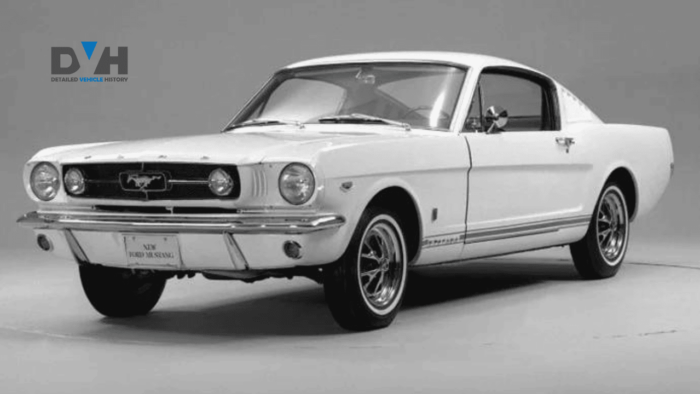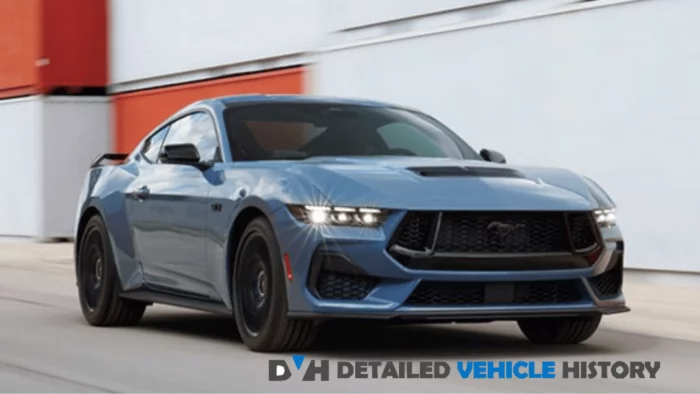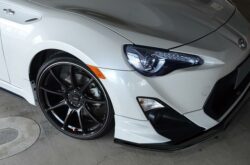The Ford Mustang, a timeless symbol of American muscle cars, stands as a testament to automotive ingenuity.
Conceived by the Ford executive Lee Iacocca, this iconic vehicle made its debut in 1964, captivating the world’s imagination.
Beyond being a mere mode of transport, the Mustang transcends into a cultural phenomenon, embodying speed, style, and the spirit of freedom.
Its journey through six generations mirrors the evolution of American automotive excellence, leaving an indelible mark on the highways of history.
Brief History of the Ford Mustang
The Ford Mustang’s storied legacy began with an unconventional early release in March 1964, five months ahead of the typical production schedule.
Initially presented as a 1965 model, it made its public debut at the New York World’s Fair on April 17, 1964.
Rooted in the second-gen Ford Falcon, the Mustang emerged as a sleek and customizable alternative.
Its distinct features, including the iconic running horse grille, side scallops, and tiered tail lights, set it apart.
The Mustang’s allure extended beyond aesthetics. Carroll Shelby, recognizing its racing potential, transformed 100 early 2+2 models into the legendary ‘GT 350.’
This marked the inception of a lineage that included iconic variants like the Boss 302, Boss 429, Mach 1, and Boss 351, along with the renowned Shelby Mustangs.
Throughout its first gen (1964-1974), the Mustang underwent four evolutions, each marked by styling and mechanical enhancements.
From the compact yet powerful early models to the larger, more robust repeated versions of the early 1970s, the first-gen Mustangs played a pivotal role in shaping the pony car segment.
With its rich history and diverse offerings, the Ford Mustang left an unerasable impression on the automotive landscape, setting the stage for the generations that followed.

The First Generation Ford Mustang (1964 - 1974)
The inaugural chapter of the first Ford Mustang saga unfolded in 1964, introducing an automotive marvel that transcended conventional boundaries.
Officially designated as a 1965 model, the ’64 1/2 models witnessed a groundbreaking debut at the New York World’s Fair.
This first-gen pioneered the pony car segment, offering diverse body styles—convertibles, fastbacks, and hardtops—powered by a range of inline-six and V8 engines.
Across four transformative evolutions spanning 1965-1973, the 1965 model year Mustang continually evolved, responding to shifting tastes and industry dynamics.
From the sleek charm of the early years to the enhanced size and power of the late ’60s and early ’70s, each iteration maintained the Mustang’s iconic status.
The introduction of legendary variants like the Boss 302, Boss 429, and Shelby Mustang further solidified its cultural impact, leaving an indelible mark on the annals of American automotive history.
Exploring The 4 Evolutions of the First-gen Ford Mustang
First Evolution (1965 – 1966):
The 1965-1966 First-generation Mustang, often referred to as “1964-1/2,” marked a historic debut, captivating the automotive landscape. Released a few months before the traditional start of the 1965 production year, these early Mustangs introduced the iconic fastback coupe alongside the hardtop and convertible body styles. With offerings like the Base Model and GT, featuring inline six and V8 engines, the Mustang swiftly gained popularity, serving as a canvas for customization and racing modifications. Notable variants, such as the Mustang A/FX for drag racing, underscored its versatility, setting the stage for subsequent evolutions.
Second Evolution (1967 – 1968):
The 1967-1968 Mustang witnessed substantial updates, embracing size enhancements and diverse engine options. This era saw the introduction of the big block V8, expanding performance capabilities. Notable variants like the California Special and Cobra Jet added flair to the lineup, appealing to enthusiasts seeking a blend of power and style. The Mustang’s suspension and steering underwent refinements, enhancing its overall performance and comfort. The 1967-1968 models, still sought after for customization and racing endeavors, demonstrated the Mustang’s evolution into a well-rounded, dynamic automobile.
Third Evolution (1969 – 1970):
The 1969-1970 Mustang represented a period of growth and diversification. This generation featured longer and heavier designs, offering hardtop, fastback (SportsRoof), and convertible body styles. With a range of engine choices, including inline six and various V8 options, the Mustang catered to a broader audience. The introduction of high-performance variants like the Mach 1 and Boss 302 showcased the brand’s commitment to innovation and motorsports. The Mustang’s adaptability to changing market demands and its continued success in racing circuits solidified its status as a versatile and enduring icon.
Fourth Evolution (1971 – 1973):
The 1971-1973 Mustang, while navigating the challenges of emissions regulations, maintained its appeal with sleek redesigns. Available in hardtop, convertible, and fastback (SportsRoof) options, this generation featured a standard inline six engine and various V8 choices. Performance enthusiasts could still enjoy models like the Boss 351 and Mach 1. Despite industry shifts impacting engine performance, the 1971-1973 Mustang remained popular, adapting to changing times. Its enduring legacy and continued presence in the custom car and racing scenes underscored the Mustang’s resilience and ability to capture the essence of each era
Timeline: The Generations of Mustang
The Mustang has evolved through six generations (1965-present) with each bringing unique designs, offerings, and performance improvements. The Ford Mustang remains a powerful and stylish car.
First Generation (1965 – 1973):
- The first Mustang was introduced in 1964
- Four distinct evolutions: 1965-1966, 1967-1968, 1969-1970, 1971-1973
- The inaugural gen established the Mustang’s iconic status, introducing classic variants like the Boss 302 and Shelby Mustang.
Second Generation (1974 – 1978):
- A challenging era marked by design changes due to fuel efficiency concerns and emissions regulations.
Third Generation (1979 – 1993):
- Witnessed a return to performance-oriented models after a focus on efficiency during the second generation.
Fourth Generation (1994 – 2004):
- A modernized design and a resurgence of performance with models like the SVT Cobra and Bullitt.
Fifth Generation (2005 – 2014):
- A retro-inspired design, bringing back classic cues, and featuring powerful engines like the GT500.
Sixth Generation (2015 – Present):
- Current models showcase cutting-edge technology, increased performance, and a continued commitment to the Mustang’s legacy.
Did you know there is still a lot to discover about the classic Ford Mustang?
If you’re a classic car or Ford Mustang enthusiast and in the market to buy a used one or want to know more about any classic car, you can quickly look up the classic vehicle history and build sheet to verify the car’s rich history and the original options and features respectively. Checking a vehicle history and verifying the features can help you to confidently and easily decide which vehicle is more suitable for you.
The Ford Mustang stands as a testament to automotive greatness, seamlessly blending style and power across its six generations. Beyond its impressive performance, the Mustang has become a cultural symbol, embodying freedom and the American spirit. With appearances in various media and a legacy spanning nearly six decades, the original Mustang remains an enduring classic. Its ability to adapt while staying true to its roots ensures its continued influence, inspiring generations of drivers and securing its place in auto history.
Frequently Asked Questions
Over 1 million First-Gen Mustang models were sold within the first 18 months of its introduction, making it a phenomenal success for Ford.
The First Ford Mustang rolled out saw the release of iconic models such as the Mustang GT, Mustang Fastback, and the high-performance Shelby GT350 and Shelby GT500 editions.
The Ford Mustang boasts a storied legacy as a pioneering pony car that revolutionized the automotive landscape since its debut in 1964. Its enduring influence extends beyond the road, symbolizing freedom, youth, and the American spirit, making it an iconic cultural phenomenon.
The Mustang Mach-E represents a pivotal shift in the Mustang legacy, embracing electric power and cutting-edge technology. Contrasting with the traditional V8-powered models of the fifth and sixth gen, such as the 2005 Mustang, the Mach-E exemplifies Ford’s commitment to innovation, sustainability, and the continued evolution of the Mustang lineage.
Simply think of a system designed to lock and unlock doors while keeping the original door latches and handles intact.










